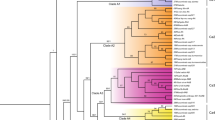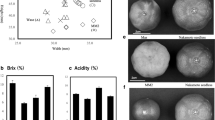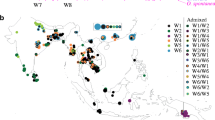Abstract
Twelve accessions classified as Pisum sativum subsp. elatius, mostly from West and Central Mediterranean, were analysed for three markers from different cellular genomes: rbcL (plastid genome), coxI (mitochondrial genome) and SCA (nuclear genome). Based on geographical distribution of their allele combinations analysed in this and the earlier study, we suggest a putative history of wild representatives of P. sativum. The ancestor of this species belonged to lineage A (coxI+, rbcL+, SCA f); it appeared in East Mediterranean, then spread westward most probably during one of the Pleistocene coolings when the sea was smaller, so that representatives of lineage A remained in the Eastern Mediterranean and on the islands of Sicily and Menorca. Mutation leading to the loss of the restriction site for PsiI in coxI−, gave rise to lineage C (coxI−, rbcL+, SCA f) which spread widely in the Mediterranean and is now found in France, Greece and Ethiopia. Mutation leading to rbcL− gave rise to lineage D (coxI−, rbcL−, SCA f), now found in Egypt (P. sativum subsp. jomardii) and Spain. Mutational transition of SCA f to SCA s most probably took place in North-Eastern Mediterranean since the resulting lineage B (coxI−, rbcL−, SCA s) now occupies the Tauro-Caucasian area. In Asia Minor and North Israel, line B met the ancestral line A so that both lines coexist there presently. The lineage B gave rise to the cultivated P. sativum subsp. sativum.

Similar content being viewed by others
References
Ambrose MJ, Ellis THM (2008) Ballistic seed dispersal and associate seed shadow in wild Pisum germplasm. Pisum Genet 40:5–10
Ben-Ze’ev N, Zohary D (1973) Species relationship in the genus Pisum L. Israel J Bot 22:73–91
Berdnikov VA, Bogdanova VS, Rozov SM, Kosterin OE (1993) The geographic patterns of histone H1 allelic frequencies formed in the course of pea (Pisum sativum L.) cultivation. Heredity 71:199–209
Bogdanova VS, Berdnikov VA (2000) A study of potential ability for cross-pollination in pea originating from different parts of the world. Pisum Genet 32:16–17
Davis H (1970) Flora of Turkey and the East Aegean Islands, vol 3. Edinburgh
Jing R, Johnson R, Seres A, Kiss G, Ambrose MJ, Knox MR, Ellis THN, Flawell AJ (2007) Gene-based sequence diversity analysis of wild pea (Pisum). Genetics 177:2263–2275
Kosterin O, Bogdanova V (2008) Relationship of wild and cultivated forms of Pisum L. as inferred from an analysis of three markers, of the plastid, mitochondrial and nuclear genomes. Genet Res Crop Evol 55:735–755
Loenning W-E (1984) Cross fertilization in peas under different ecological conditions. Pisum Newsl 16:38-40
Makasheva RK (1979) Kul’turnaya flora SSSR [Cultivated Flora of the USSR] vol. 4, Leningrad, p 1324 (in Russian)
Maxted N, Ambrose M (2001) Peas (Pisum L.). In: Maxted N, Bennett SJ (eds) Plant genetic resources of legumes in the Mediterranean, vol 10. Kluwer Academic Publishers, The Netherlands, pp 181–190
Townsend C (1968) Contribution to the flora of Iraq. V. Notes on Leguminosales. Kew Bull. Roy Bot Gard 21(3):435–458
Vershinin AV, Allnutt TR, Knox MR, Ambrose MJ, Ellis THN (2003) Transposable elements reveal the impact of introgression rather than transposition, in Pisum diversity, evolution and domestication. Mol Biol Evol 20:2067–2075
Acknowledgments
This work was supported by Russian Foundation for Fundamental Research, grant 07-04-00111-a and the State Contract No. 02.512.11.2254 by Russian Agency of Science and Innovations. Financial support for the maintenance of the JI Pisum collection from Defra is also gratefully acknowledged. Sequencing was performed at DNA Sequencing Center, ICG-ICBFM SD RAS. We are grateful to Michel Papazyan for kindly collecting seeds of wild pea.
Author information
Authors and Affiliations
Corresponding author
Rights and permissions
About this article
Cite this article
Kosterin, O.E., Zaytseva, O.O., Bogdanova, V.S. et al. New data on three molecular markers from different cellular genomes in Mediterranean accessions reveal new insights into phylogeography of Pisum sativum L. subsp. elatius (Bieb.) Schmalh.. Genet Resour Crop Evol 57, 733–739 (2010). https://doi.org/10.1007/s10722-009-9511-6
Received:
Accepted:
Published:
Issue Date:
DOI: https://doi.org/10.1007/s10722-009-9511-6




